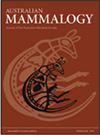A search for the desert rat-kangaroo or ngudlukanta (Caloprymnus campestris) in north-eastern South Australia
IF 1.2
4区 生物学
Q3 ZOOLOGY
引用次数: 1
Abstract
The desert rat-kangaroo or ‘ngudlukanta’ (Caloprymnus campestris) was once sparsely distributed in the Lake Eyre Basin of north-eastern South Australia and adjacent parts of Queensland, but has not been collected since the 1930s. However, numerous reported sightings, including some recent, provide some hope that it may still be extant. In 2018 and 2019, we searched for evidence of this species at sites where it had been collected in the 1930s, and at places where people have since reported seeing an animal that fits its description. Our survey, which analysed data from more than 6000 camera trap nights, 536 predator scats and 226 km of spotlight transects, was the most extensive field-based search ever undertaken for this animal; but we found no evidence for its continued existence. However, our work did detect other threatened species including a range extension for the kowari (Dasyuroides byrnei), thereby demonstrating the value of surveys like this one. Because of the vastness and inaccessibility of much of the terrain comprising the supposed distribution of C. campestris, we do not see our null result as definitive for this poorly surveyed animal; we instead hope that it provides a starting point for future surveys aimed at resolving its status.在南澳大利亚东北部寻找沙漠鼠袋鼠或ngudlukanta(Caloprymnus campestris)
沙漠鼠袋鼠或“ngudlukanta”(Caloprymnus campestris)曾经稀疏分布在南澳大利亚东北部的艾尔湖盆地和昆士兰的邻近地区,但自20世纪30年代以来就没有被采集过。然而,许多报道的目击事件,包括最近的一些,为它可能仍然存在提供了一些希望。2018年和2019年,我们在20世纪30年代采集该物种的地点,以及后来人们报告看到符合其描述的动物的地方,寻找该物种的证据。我们的调查分析了6000多个摄像头陷阱夜晚、536只捕食者粪便和226只捕食者粪便的数据 公里的聚光灯样带,是有史以来对这种动物进行的最广泛的实地搜索;但我们没有发现它继续存在的证据。然而,我们的工作确实检测到了其他受威胁的物种,包括科瓦里(Dasyuroides byrnei)的范围扩展,从而证明了此类调查的价值。由于构成C.campestris假定分布的大部分地形广阔且难以接近,我们认为我们的无效结果对这种调查不足的动物来说并不是决定性的;相反,我们希望它能为未来旨在解决其地位问题的调查提供一个起点。
本文章由计算机程序翻译,如有差异,请以英文原文为准。
求助全文
约1分钟内获得全文
求助全文
来源期刊

Australian Mammalogy
ZOOLOGY-
CiteScore
2.50
自引率
8.30%
发文量
26
期刊介绍:
Australian Mammalogy is a major journal for the publication of research in all branches of mammalogy. The journal’s emphasis is on studies relating to Australasian mammals, both native and introduced, and includes marine mammals in the Antarctic region. Subject areas include, but are not limited to: anatomy, behaviour, developmental biology, ecology, evolution, genetics, molecular biology, parasites and diseases of mammals, physiology, reproductive biology, systematics and taxonomy.
Australian Mammalogy is for professional mammalogists, research scientists, resource managers, consulting ecologists, students and amateurs interested in any aspects of the biology and management of mammals.
Australian Mammalogy began publication in 1972 and is published on behalf of the Australian Mammal Society.
 求助内容:
求助内容: 应助结果提醒方式:
应助结果提醒方式:


